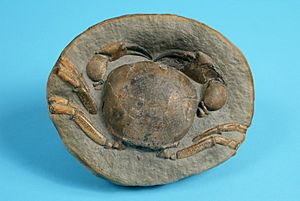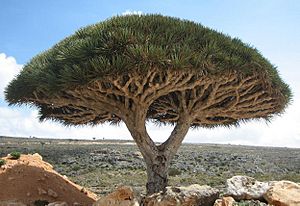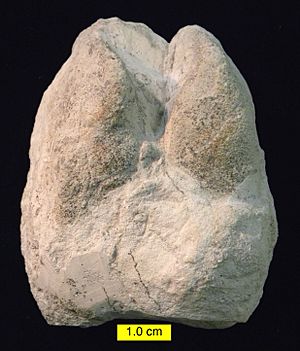Miocene facts for kids
The Miocene was a time in Earth's history that started about 23 million years ago and ended around 5.33 million years ago. It's the first part of the Neogene period, which is part of the Cainozoic Era. During this time, many plants and animals started to look more like the ones we see today.
A scientist named Sir Charles Lyell gave the Miocene its name. The name comes from Greek words meaning "less recent". This is because it had fewer modern sea creatures compared to the time period that came after it, the Pliocene.
The Earth slowly cooled down during the Miocene. This epoch was a bridge between the warmer Oligocene epoch and the cooler Pliocene epoch. The plants and animals of the Miocene were quite similar to modern ones. Many modern families of mammals and birds already existed. Things like whales, seals, and kelp forests became common. Huge sharks like the Megalodon also appeared.

Contents
Life in the Miocene
Life during the Miocene Epoch was greatly helped by two new types of environments: kelp forests and grasslands. Grasslands allowed many more plant-eating animals, like horses and rhinoceroses, to thrive. By the end of this epoch, about 95% of the plant types we see today already existed.
Miocene Plants (Flora)
During the Miocene, grasses became very common. These grasses were tough and could survive fires. At the same time, long-legged animals with high-crowned teeth (perfect for grinding grass) also became common. This led to a huge spread of grass-eating ecosystems. Large herds of swift grazers roamed across wide open grasslands, with predators following them. This changed many areas that used to be deserts or woodlands.
The spread of grasslands also helped cool the Earth. Grassland soils hold more water and carbon, which helped reduce greenhouse gases in the air. A special type of grass, called C4 grasses, became very important towards the end of the Miocene. These grasses are very good at using carbon dioxide and water efficiently.
Miocene Animals (Fauna)
Both land and sea animals in the Miocene were quite modern. However, there were fewer types of marine mammals than there are today. Only in places like South America and Australia did very different types of animals still exist.
In the early Miocene, some older groups of animals were still around. These included nimravids (saber-toothed cat relatives) and entelodonts (pig-like animals). As the Miocene continued, mammals became even more modern. We start to see animals that look like modern dogs, bears, raccoons, horses, beavers, deer, camelids, and whales. There were also groups that are now extinct, like certain types of gomphotheres (elephant relatives) and three-toed horses.
Towards the end of the Miocene, islands started to form between North and South America. This allowed some animals, like giant ground sloths, to "island-hop" and move into North America. The spread of tough, silica-rich C4 grasses led to many plant-eating species dying out if they didn't have high-crowned teeth to chew them.
Many modern bird groups appeared during the Miocene. These included ducks, plovers, owls, cockatoos, and crows. By the end of the epoch, almost all modern bird groups were present. Marine birds, like penguins, also became very diverse.
About 100 different types of apes lived during this time. They were found across Africa, Asia, and Europe. These apes varied a lot in size and what they ate. Scientists believe that the first hominins (apes that walked on two legs, like early humans) appeared in Africa at the very end of the Miocene. Examples include Sahelanthropus and Orrorin.
The growth of grasslands in North America also led to a huge increase in the number of snake species. Before the Miocene, snakes were not very common. But during this time, many new types of snakes appeared, including vipers and elapids. Many modern snake groups, like water snakes and kingsnakes, also began to evolve.
In the oceans, brown algae, known as kelp, grew in huge forests. These kelp forests provided homes and food for many new sea creatures. These included otters, different kinds of fish, and many invertebrates (animals without backbones).
Whales reached their greatest variety during the Miocene. There were over 20 different types of whales, compared to only six living types today. This was also a time when giant predators like the huge megatoothed sharks and powerful sperm whales, such as L. melvillei, became common.
Crocodiles also became more diverse during the Miocene. The largest crocodile was a giant caiman called Purussaurus that lived in South America. Another huge crocodile, Rhamphosuchus, lived in what is now India. A strange crocodile called Mourasuchus also lived alongside Purussaurus. This crocodile had a special way of filter-feeding, probably eating small animals despite its huge size.
Pinnipeds (like seals and walruses), which first appeared in the Oligocene, became even more adapted to water. A fierce walrus called Pelagiarctos might have hunted other pinnipeds.
The Miocene fossil record in New Zealand is very rich. It shows many types of whales and penguins, helping us understand how these groups evolved. The early Miocene Saint Bathans Fauna in New Zealand is special because it's the only land fossil record from the Cenozoic Era there. It shows many bird species, including early moas and kiwis, as well as crocodiles, turtles, and different types of bats.
Miocene Oceans and Climate
Scientists have found evidence from ocean sediments that ice started to build up in Antarctica about 36 million years ago. There were more big drops in temperature during the Middle Miocene, around 15 million years ago. This likely means that the ice in Antarctica grew even more. So, it's believed that East Antarctica had some glaciers during the early to mid-Miocene (23–15 million years ago).
The oceans also cooled partly because of the formation of the Antarctic Circumpolar Current. This is a strong ocean current that flows around Antarctica, keeping warm water away. Around 15 million years ago, the ice cap in the southern hemisphere began to grow to its current size. The ice cap in Greenland developed later, about 3 million years ago, during the Middle Pliocene.
Images for kids
See also
 In Spanish: Mioceno para niños
In Spanish: Mioceno para niños







